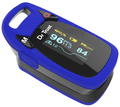

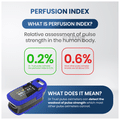
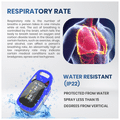
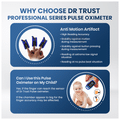
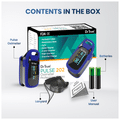
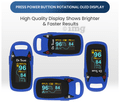

Dr Trust USA Professional Series Finger Tip Pulse Oximeter Blue
Product highlights
- Measures SpO2 (blood oxygen saturation levels) and pulse rate
- Facilitates large digital bright OLED display
- Comes with a rotatable multidirectional display
- Has simple one-button design for ease of use
MRP₹3345Discount Percentage: 31% off
₹Discounted Price: 2321
Inclusive of all taxes
of1 Unit
SOLD OUT
Information about Dr Trust USA Professional Series Finger Tip Pulse Oximeter Blue
It is used to check pulse rate and blood oxygen saturation levels. It is recommended for people suffering from lung problems as it helps to monitor blood oxygen saturation level (spO2). It is also known to help monitor pulse rate and blood perfusion index which are also key indicators of how well your lungs are functioning. In recent COVID times, it has become a household name after health professionals started to shed light on the significance of this small, portable tool in detecting low levels of oxygen due to COVID-19, especially in people who are asymptomatic (do not show any symptoms).
A pulse oximeter acts as an early-detection device and can be a wise option to track your lung health regularly at home. Doctors often recommend it for patients with lung diseases or respiratory problems as this helps them keep a track of how well their treatment procedure is working and whether their oxygen levels are at optimum level or not.
A pulse oximeter has a sensor and a monitor to display readings. The device uses wavelengths of light to measure changes of light absorption in oxygenated or deoxygenated blood. There is no pricking involved which makes the entire process quick and painless. Simply place your finger in the provided slot to get instant readings of the percentage of arterial hemoglobin, pulse rate, and pulse strength at the touch of a button. The readings are displayed on a bright and clear OLED display. The product is suitable for use in family, hospital, community healthcare, and physical care in sports.
Buying an oximeter won’t do any harm unless you don’t depend on it. Always remember that a pulse oximeter is just equipment and can in no way replace the guidance and treatment of a doctor.
The device emits beams of light that pass through the body part you have clipped it on. These beams calculate the amount of oxygen by measuring the changes in the absorption of light. It also calculates your heart rate or pulse.
BPM stands for beats per minute, referring to your pulse rate which is an estimation of the number of times your heart contracts per minute. According to the Mayo Clinic, normal pulse rate values for adults range from 60 to 100 beats per minute (bpm). In general, a lower heart rate at rest implies more efficient heart function and better cardiovascular fitness.
It is the oxygen level of your body as calculated by the pulse oximeter. SpO2 or oxygen saturation level is the percentage of how much oxygen your blood is carrying compared to the maximum amount it can carry. This number should ideally be above 90-92%. A percentage lower than that may require medical consultation.
A pulse oximeter measures two things: blood oxygen saturation (SpO2) and pulse rate/heart rate. Pulse oximeters can help in detecting silent hypoxia where a person’s oxygen levels may fall below normal without showing any symptoms. On-time detection helps in getting it treated before it takes a rough turn.
Normal pulse oximeter readings usually range from 95 to 100 percent. Values under 90 percent are considered low.
To check your oxygen level, you need to use a pulse oximeter that measures the amount of oxygen in the blood. The SpO2 reading on the oximeter is an estimation of the amount of oxygen flowing in your blood.
The symptoms of low blood oxygen levels are shortness of breath, headache, restlessness, dizziness, rapid breathing, chest pain, and confusion.
References:
A pulse oximeter acts as an early-detection device and can be a wise option to track your lung health regularly at home. Doctors often recommend it for patients with lung diseases or respiratory problems as this helps them keep a track of how well their treatment procedure is working and whether their oxygen levels are at optimum level or not.
A pulse oximeter has a sensor and a monitor to display readings. The device uses wavelengths of light to measure changes of light absorption in oxygenated or deoxygenated blood. There is no pricking involved which makes the entire process quick and painless. Simply place your finger in the provided slot to get instant readings of the percentage of arterial hemoglobin, pulse rate, and pulse strength at the touch of a button. The readings are displayed on a bright and clear OLED display. The product is suitable for use in family, hospital, community healthcare, and physical care in sports.
Buying an oximeter won’t do any harm unless you don’t depend on it. Always remember that a pulse oximeter is just equipment and can in no way replace the guidance and treatment of a doctor.
Product Specifications and Features:
- Water-resistant design to withstand an accidental splash of water
- Accurately displays pulse rate and respiratory rate
- The rotatable multidirectional display allows us to view results in any direction
- The box includes: Pulse Oximeter, Two batteries, User manual, Lanyard, Flexible tip digital thermometer
- Pulse rate/Heart rate: Yes
- Alarm: Yes
- Anti-motion measurement: Yes
- Multi-colour models: Yes
- Display (LCD/LED): OLED
Key benefits/uses of Dr. Trust USA Professional Series Finger Tip Pulse Oximeter:
- Helps to check the oxygen levels of the blood in a non-invasive way that too within seconds
- Helps to know your pulse rate and blood perfusion index
- Aids in monitoring the treatment for people with lungs and respiratory problems
- Helps to keep a tab on overall lung function
- Can be used in family, hospital, oxygen bar, and community healthcare
Directions for use:
This is a completely painless procedure, where a clip-like device called a probe is placed usually on your fingers. The idea is to place it on any of the body parts that lie farthest to the heart, so some devices may need their probes to be placed on the earlobe, toe, forehead, etc.The device emits beams of light that pass through the body part you have clipped it on. These beams calculate the amount of oxygen by measuring the changes in the absorption of light. It also calculates your heart rate or pulse.
Quick tips for Dr. Trust USA Professional Series Finger Tip Pulse Oximeter Blue:
- To make sure that your oximeter is giving the correct reading, count your pulse simultaneously while using the oximeter. Same readings mean your oximeter is working well.
- Nail polish, artificial nails, reduced circulation, and cold hands may affect the readings. Rectify this by placing the probe at the base of the nail or by clipping the probe sideways or by clipping it on the earlobe.
- For accurate results, the hand should be warm, relaxed, and lower than your heart’s level. Also, make sure your body is calm, not in an excited state so that the blood is flowing through your hands properly.
- Do not smoke as smoking increases the amount of carbon monoxide in blood and pulse oximeters cannot differentiate between oxygen and carbon monoxide. This can lead to inaccurate results, showing a percentage that’s higher than the actual oxygen level in your body.
- Inaccurate results may be obtained if the probe doesn’t work properly. In such a case, contact your doctor.
- Shivering or any hand movement when using the probe can make it difficult for the probe to pick up a signal.
Storage and safety information:
- Read the label carefully before use.
- Store in a cool dry place away from direct sunlight.
- Keep out of reach of the children.
FAQs related to Dr. Trust USA Professional Series Fingertip Pulse Oximeter Blue:
Q. How do you use Dr. Trust Pulse Oximeter?
You have to place your finger in the slot provided in the device. The readings are displayed on the LED display. The device shows you the percentage of the arterial hemoglobin, pulse rate as well as pulse strength at the touch of a button along with oxygen saturation (SpO2).
Q. What is BPM on an oximeter?
BPM stands for beats per minute, referring to your pulse rate which is an estimation of the number of times your heart contracts per minute. According to the Mayo Clinic, normal pulse rate values for adults range from 60 to 100 beats per minute (bpm). In general, a lower heart rate at rest implies more efficient heart function and better cardiovascular fitness.
Q. What is SpO2?
It is the oxygen level of your body as calculated by the pulse oximeter. SpO2 or oxygen saturation level is the percentage of how much oxygen your blood is carrying compared to the maximum amount it can carry. This number should ideally be above 90-92%. A percentage lower than that may require medical consultation.
Q. What are the 2 readings on a pulse oximeter?
A pulse oximeter measures two things: blood oxygen saturation (SpO2) and pulse rate/heart rate. Pulse oximeters can help in detecting silent hypoxia where a person’s oxygen levels may fall below normal without showing any symptoms. On-time detection helps in getting it treated before it takes a rough turn.
Q. Is 92 blood oxygen level OK?
Normal pulse oximeter readings usually range from 95 to 100 percent. Values under 90 percent are considered low.
Q. How do I check my oxygen level?
To check your oxygen level, you need to use a pulse oximeter that measures the amount of oxygen in the blood. The SpO2 reading on the oximeter is an estimation of the amount of oxygen flowing in your blood.
Q. What are the symptoms of insufficient oxygen in the blood?
The symptoms of low blood oxygen levels are shortness of breath, headache, restlessness, dizziness, rapid breathing, chest pain, and confusion.References:
Chetan Puri
Verified Buyer
7 May 2021
Colour: Blue
Reading variations
 HELPFUL
HELPFUL REPORT
REPORTRoshan Khapre
Verified Buyer
21 May 2021
Colour: Blue
its reliable
 HELPFUL
HELPFUL REPORT
REPORTCountry of origin: China
 Authentic Products
Authentic Products Great Savings
Great Savings Home Delivery
Home Delivery






